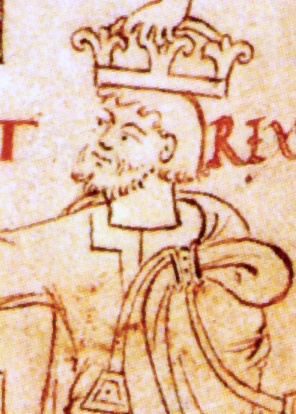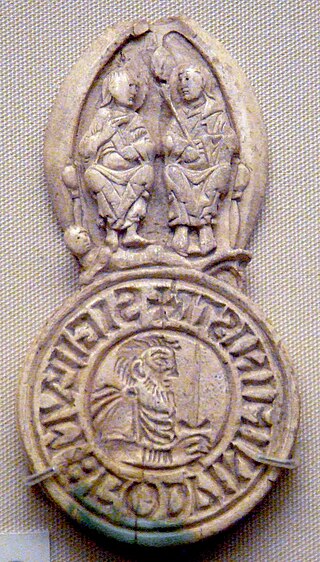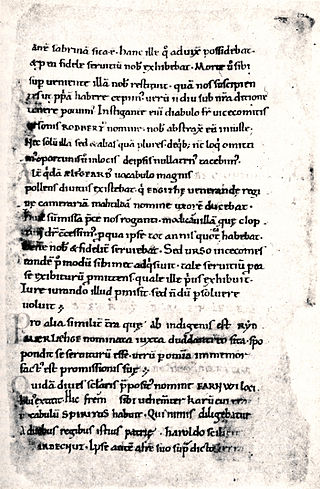Related Research Articles

Alfred the Great was King of the West Saxons from 871 to 886, and King of the Anglo-Saxons from 886 until his death in 899. He was the youngest son of King Æthelwulf and his first wife Osburh, who both died when Alfred was young. Three of Alfred's brothers, Æthelbald, Æthelberht and Æthelred, reigned in turn before him. Under Alfred's rule, considerable administrative and military reforms were introduced, prompting lasting change in England.

Æthelred II, known as Æthelred the Unready, was King of the English from 978 to 1013 and again from 1014 until his death in 1016. His epithet does not derive from the modern word "unready", but rather from the Old English unræd meaning "poorly advised"; it is a pun on his name, which means "well advised".

The Anglo-Saxons were a cultural group that inhabited much of what is now England in the Early Middle Ages, and spoke Old English. They traced their origins to settlers who came to Britain from mainland Europe in the 5th century. Although the details are not clear, their cultural identity developed out of the interaction of incoming groups of Germanic peoples, with the pre-existing Romano-British culture. Over time, most of the people of what is now southern, central, northern and eastern England came to identify as Anglo-Saxon and speak Old English. Danish and Norman invasions later changed the situation significantly, but their language and political structures are the direct predecessors of the medieval Kingdom of England, and the Middle English language. Although the modern English language owes somewhat less than 26% of its words to Old English, this includes the vast majority of words used in everyday speech.

The Witan was the king's council in Anglo-Saxon government of England from before the seventh century until the 11th century. It was composed of the leading magnates, both ecclesiastic and secular, and meetings of the council were sometimes called the Witenagemot. Its primary function was to advise the king on subjects such as promulgation of laws, judicial judgments, approval of charters transferring land, settlement of disputes, election of archbishops and bishops and other matters of major national importance. The witan also had to elect and approve the appointment of a new king. Its membership was composed of the most important noblemen, including ealdormen, thegns, and senior clergy.
Godwin of Wessex was an English nobleman who became one of the most powerful earls in England under the Danish king Cnut the Great and his successors. Cnut made Godwin the first Earl of Wessex. Godwin was the father of King Harold II and of Edith of Wessex, who in 1045 married King Edward the Confessor.

Cnut, also known as Cnut the Great and Canute, was King of England from 1016, King of Denmark from 1018, and King of Norway from 1028 until his death in 1035. The three kingdoms united under Cnut's rule are referred to together as the North Sea Empire.

Copyhold was a form of customary land ownership common from the Late Middle Ages into modern times in England. The name for this type of land tenure is derived from the act of giving a copy of the relevant title deed that is recorded in the manorial court roll to the tenant; not the actual land deed itself. The legal owner of the manor land remained the mesne lord, who was legally the copyholder, according to the titles and customs written down in the manorial roll. In return for being given land, a copyhold tenant was required to carry out specific manorial duties or services. The specific rights and duties of copyhold tenants varied greatly from one manor to another and many were established by custom. By the 19th century, many customary duties had been replaced with the payment of rent.
Tostig Godwinson was an Anglo-Saxon Earl of Northumbria and brother of King Harold Godwinson. After being exiled by his brother, Tostig supported the Norwegian king Harald Hardrada's invasion of England, and was killed alongside Hardrada at the Battle of Stamford Bridge in 1066.
Ælfgifu of Northampton was the first wife of Cnut the Great, King of England and Denmark, and mother of Harold Harefoot, King of England. She was regent of Norway from 1030 to 1035.

A fyrd was a type of early Anglo-Saxon army that was mobilised from freemen or paid men to defend their Shire's lords estate, or from selected representatives to join a royal expedition. Service in the fyrd was usually of short duration and participants were expected to provide their own arms and provisions.

In later Anglo-Saxon England, 10th to 11th centuries, a thegn or thane was an aristocrat who owned substantial land in one or more counties. Thanes ranked at the third level in lay society, below the king and ealdormen. Thanage refers to the tenure by which lands were held by a thane as well as the rank.

A housecarl was a non-servile manservant or household bodyguard in medieval Northern Europe.

Anglo-Saxon law is a body of written rules and customs that were in place during the Anglo-Saxon period in England, before the Norman conquest. This body of law, along with early Medieval Scandinavian law and Germanic law, descended from a family of ancient Germanic custom and legal thought. However, Anglo-Saxon law codes are distinct from other early Germanic legal statements—known as the leges barbarorum, in part because they were written in Old English instead of in Latin. The laws of the Anglo-Saxons were the second in medieval Western Europe after those of the Irish to be expressed in a language other than Latin.

Eadric Streona was Ealdorman of Mercia from 1007 until he was killed by King Cnut. Eadric was given the epithet "Streona" in Hemming's Cartulary because he appropriated church land and funds for himself. Eadric became infamous in the Middle Ages because of his traitorous actions during the Danish re-conquest of England.
Uhtred of Bamburgh, was ruler of Bamburgh and from 1006 to 1016 the ealdorman of Northumbria. He was the son of Waltheof I, ruler of Bamburgh (Bebbanburg), whose family the Eadwulfings had ruled the surrounding region for over a century. Uhtred's death by assassination was described in De obsessione Dunelmi and has been interpreted as the beginning of a blood feud. Not to be confused with Uhtred the son of Eadwulf I of Bamburgh, which is why he historically has been referred to as Uhtred the Bold.

The period of Anglo-Saxon warfare spans the 5th century AD to the 11th in Anglo-Saxon England. Its technology and tactics resemble those of other European cultural areas of the Early Medieval Period, although the Anglo-Saxons, unlike the Continental Germanic tribes such as the Franks and the Goths, do not appear to have regularly fought on horseback.

Wulfric, called Wulfric Spot or Spott, was an Anglo-Saxon nobleman. His will is an important document from the reign of King Æthelred the Unready. Wulfric was a patron of the Burton Abbey, around which the modern town of Burton on Trent later grew up, and may have refounded the Benedictine monastery there.
Geþyncðo, meaning “Dignities”, is the title given to an Old English legal tract on status and social mobility, probably written by Wulfstan (II), Archbishop of York between 1002 and 1023. It is sometimes known as one of the so-called 'promotion laws', along with Norðlleoda laga, and both these texts belong to a legal compilation on status, dubbed ‘the Geþyncðu group’ by the historian Patrick Wormald. Though the extent to which these reflect reality is a topic of some debate, they constitute one of the most valuable primary documents for an understanding of social status in late Anglo-Saxon England.
Thurbrand, nicknamed "the Hold", was a Northumbrian magnate in the early 11th century. Perhaps based in Holderness and East Yorkshire, Thurbrand was recorded as the killer of Uhtred the Bold, Earl of Northumbria. The killing appears to have been part of the war between Sweyn Forkbeard and Cnut the Great against the English king Æthelred the Unready, Uhtred being the latter's chief Northumbrian supporter. Thurbrand may also have attested a charter of 1009 and given a horse to Æthelred's son Æthelstan Ætheling. The killing is the first-known act, if it did not initiate, a bloodfeud between Thurbrand's family and Uhtred going into the time of Earl Waltheof. It is possible that Holderness took its name because of Thurbrand's presence or ownership of the peninsula.

Feudalism as practiced in the Kingdoms of England during the medieval period was a state of human society that organized political and military leadership and force around a stratified formal structure based on land tenure. As a military defence and socio-economic paradigm designed to direct the wealth of the land to the king while it levied military troops to his causes, feudal society was ordered around relationships derived from the holding of land. Such landholdings are termed fiefdoms, traders, fiefs, or fees.
References
- 1 2 Chisholm 1911.
- ↑ Brooks, "Arms, status and warfare", pp. 91–2.
- ↑ Friar, Stephen (2001). The Sutton Companion to Local History (rev. ed.). Stroud: Sutton Publishing. p. 209. ISBN 0-7509-2723-2.
- Abels, Richard. Lordship and Military Obligation in Anglo-Saxon England. London, 1988.
- Abels, Richard. "Heriot." The Blackwell Encyclopedia of Anglo-Saxon England, ed. Michael Lapidge et al. Oxford: Blackwell: 1999. 235–6.
- Brooks, Nicholas (1978). "Arms, status and warfare in late-Saxon England". In Hill, David (ed.). Ethelred the Unready: papers from the millenary conference. BAR British series. Vol. 59. Oxford: British Archaeological Reports. pp. 81–103. ISBN 086054043X.
- Stafford, Pauline. "King and kin, Lord and Community." In Gender, Family and the Legitimation of Power.
- This article incorporates text from a publication now in the public domain : Chisholm, Hugh, ed. (1911). "Heriot". Encyclopædia Britannica . Vol. 13 (11th ed.). Cambridge University Press. p. 364.